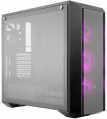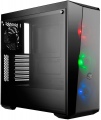Motherboard support
The type of motherboard for which the design is designed. This parameter is indicated by the form factor of the "motherboard", under which the case is designed. The options might be:
—
ATX. One of the most common types of motherboards today, the standard ATX size is 30.5x24.4 cm. It is used in both home and middle-class office PCs.
—
XL-ATX. The general name for several standards of motherboards, united, as the name implies, by rather large sizes and corresponding equipment. Specific values for these dimensions can vary from 324 to 345 mm long and 244 to 264 mm wide, depending on the manufacturer and model. Accordingly, when choosing such a case, it is worthwhile to separately clarify its compatibility with a specific motherboard.
—
E-ATX(Extended ATX). The largest type of motherboards, under which modern cases are made, has dimensions of 30.5x33 cm. It is usually used in high-performance systems that require numerous expansion slots.
— micro-ATX (m-ATX). The compact version of the ATX board has dimensions of 24.4x24.4 cm. The main scope of such boards is office systems that do not require high performance.
—
mini-ITX. One of the further reductions in the form factor of motherboards after
m-ATX assumes a board size of about 17x17 cm and one (most often) e
...xpansion slot. Also designed for compact systems that do not differ in performance.
— Thin mini-ITX. A modification of the mini-ITX described above, designed to reduce the thickness of the case (up to 25 mm), and the RAM sticks do not protrude upwards and lie on the "motherboard" parallel to the board itself (for more details, see "Form factor"). Like most compact designs, thin mini-ITX boards do not have high processing power.
Note that most cases allow the installation of smaller motherboards — for example, many E-ATX cases can be used with ATX motherboards. However, specific compatibility anyway should be clarified separately.Graphics card max lenght
The maximum length of a graphics card that can be installed in this case.
Modern mid-range and top-end video cards with high performance often differ in considerable length, which is why such a card can not fit into any case. So before collecting components, it is worth evaluating the length of the proposed graphics card and choosing a case in which it is guaranteed to fit. This forethought is useful anyway, but it's especially true if you're building a system that requires a powerful graphics adapter, such as a high-end gaming PC or 3D design workstation.
Fan max height
The highest cooler height allowed for this case.
In this case, we mean a cooler used to cool the processor — such a component is found in the vast majority of modern PCs. Height is measured relative to the motherboard.
Sidewall thickness
The thickness of the side walls used in the case. When choosing a thickness, manufacturers have to compromise between several points at once. On the one hand, thin walls are inexpensive and heat dissipates faster through them, which has a positive effect on cooling efficiency. On the other hand, powerful systems inevitably require thick walls, otherwise the case may simply not withstand the weight of advanced high-performance components. Thirdly, steel is a fairly durable material even with a relatively small thickness. In light of all this, in most models this indicator does not exceed
0.7 —
0.8 mm, and more often it is about
0.5 –
0.6 mm.
internal 2.5" compartments
The number
of internal 2.5" bays provided in the case design.
Such bays are mainly used for installing internal hard drives and SSD modules; The 2.5" form factor was originally created as "laptop" form factor, but recently it has been increasingly used in components for full-size PCs. At the same time, when evaluating the number of these bays, note that drives are recommended to be installed through a slot; so in Ideally, the number of bays should be twice the planned number of drives.
Also note that some cases use combined bays: initially they have a size of 3.5", but if desired, they can be converted to 2.5". These bays count towards both 3.5-inch and 2.5-inch slots. In fact, this means that the total number of available slots is not always equal to the sum of the number of both. For example, a case with 10 3.5" bays and 6 2.5" bays can have 4 combined bays, and the total number of slots in this case will not be 16, but only 12.
Graphics card vertical mount
The ability to install a graphics card in the case vertically, facing the side panel. To do this, the design provides for an appropriate bracket, and the graphics card is connected to the motherboard with a special extension cable — a riser. This feature is found in open cases and models with a viewing window (see relevant paragraphs), its purpose is primarily aesthetic: a vertically placed graphics card is clearly visible from the outside, which gives the case an original appearance, designed for fans of external modding. But
vertical installation does not provide any fundamental practical advantages.
Screwless
The ability to use special latches (instead of screws) to mount peripheral devices in 3.5" and 5.25 bays, as well as cards in expansion slots. This
screwless mounting greatly simplifies the installation and replacement of system components.
Dust filter
The presence of a special filter in the housing to prevent dust from entering. Without such a filter, dust settles on the system elements; Radiators are especially susceptible to this; they also lose their efficiency by becoming clogged with dust. If you have
a dust filter, you have to clean not the “filling” of the PC, but the filter element itself, which is much simpler and more convenient.
Compartments for dust filters can be located on
the front panel of the case,
back,
bottom,
top, or
in the side walls. There are also case models with several technological niches for installing dust filters - the combined version assumes the presence of such compartments on several sides of the case at once.

